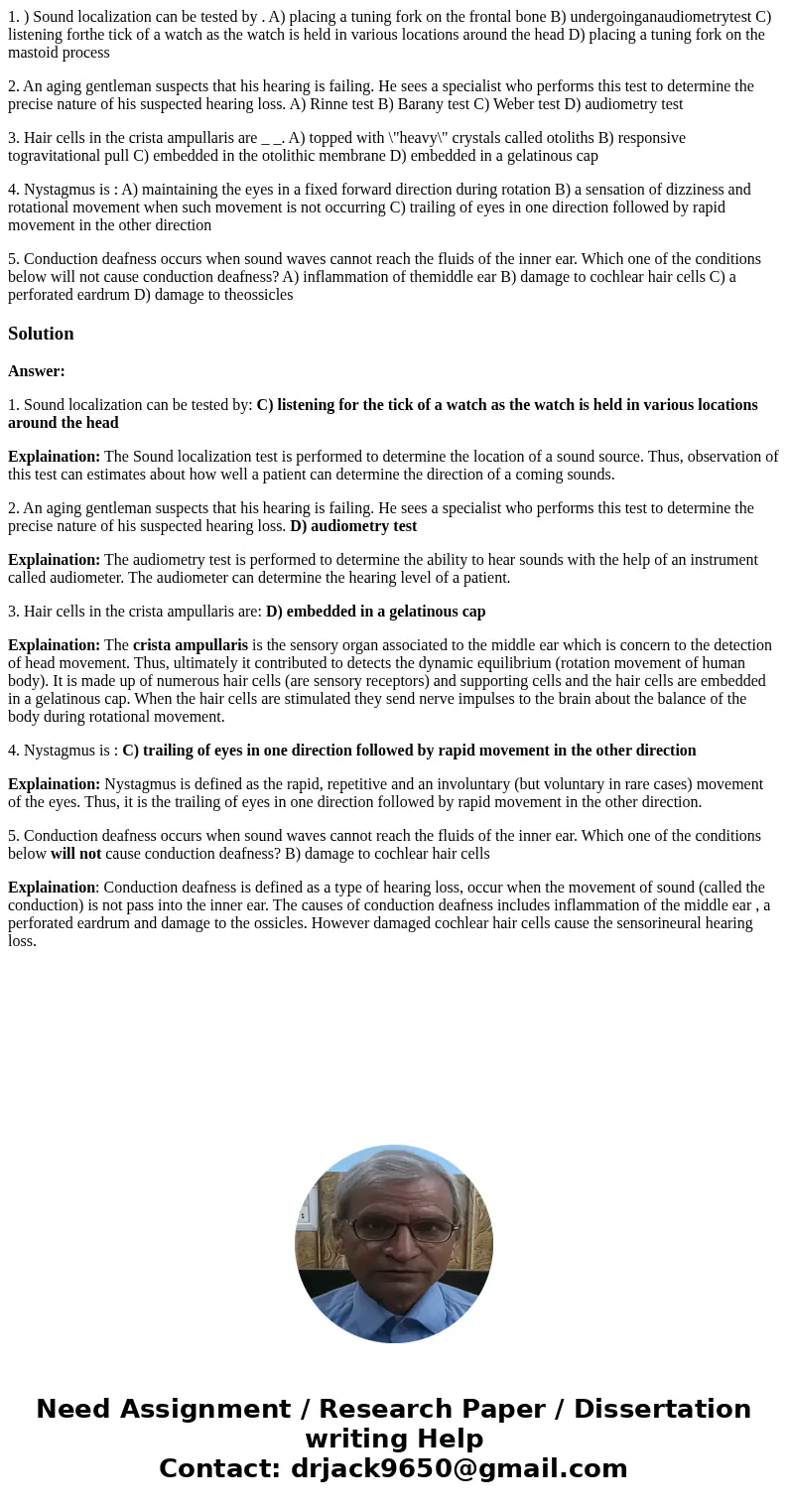1 Sound localization can be tested by A placing a tuning f
1. ) Sound localization can be tested by . A) placing a tuning fork on the frontal bone B) undergoinganaudiometrytest C) listening forthe tick of a watch as the watch is held in various locations around the head D) placing a tuning fork on the mastoid process
2. An aging gentleman suspects that his hearing is failing. He sees a specialist who performs this test to determine the precise nature of his suspected hearing loss. A) Rinne test B) Barany test C) Weber test D) audiometry test
3. Hair cells in the crista ampullaris are _ _. A) topped with \"heavy\" crystals called otoliths B) responsive togravitational pull C) embedded in the otolithic membrane D) embedded in a gelatinous cap
4. Nystagmus is : A) maintaining the eyes in a fixed forward direction during rotation B) a sensation of dizziness and rotational movement when such movement is not occurring C) trailing of eyes in one direction followed by rapid movement in the other direction
5. Conduction deafness occurs when sound waves cannot reach the fluids of the inner ear. Which one of the conditions below will not cause conduction deafness? A) inflammation of themiddle ear B) damage to cochlear hair cells C) a perforated eardrum D) damage to theossicles
Solution
Answer:
1. Sound localization can be tested by: C) listening for the tick of a watch as the watch is held in various locations around the head
Explaination: The Sound localization test is performed to determine the location of a sound source. Thus, observation of this test can estimates about how well a patient can determine the direction of a coming sounds.
2. An aging gentleman suspects that his hearing is failing. He sees a specialist who performs this test to determine the precise nature of his suspected hearing loss. D) audiometry test
Explaination: The audiometry test is performed to determine the ability to hear sounds with the help of an instrument called audiometer. The audiometer can determine the hearing level of a patient.
3. Hair cells in the crista ampullaris are: D) embedded in a gelatinous cap
Explaination: The crista ampullaris is the sensory organ associated to the middle ear which is concern to the detection of head movement. Thus, ultimately it contributed to detects the dynamic equilibrium (rotation movement of human body). It is made up of numerous hair cells (are sensory receptors) and supporting cells and the hair cells are embedded in a gelatinous cap. When the hair cells are stimulated they send nerve impulses to the brain about the balance of the body during rotational movement.
4. Nystagmus is : C) trailing of eyes in one direction followed by rapid movement in the other direction
Explaination: Nystagmus is defined as the rapid, repetitive and an involuntary (but voluntary in rare cases) movement of the eyes. Thus, it is the trailing of eyes in one direction followed by rapid movement in the other direction.
5. Conduction deafness occurs when sound waves cannot reach the fluids of the inner ear. Which one of the conditions below will not cause conduction deafness? B) damage to cochlear hair cells
Explaination: Conduction deafness is defined as a type of hearing loss, occur when the movement of sound (called the conduction) is not pass into the inner ear. The causes of conduction deafness includes inflammation of the middle ear , a perforated eardrum and damage to the ossicles. However damaged cochlear hair cells cause the sensorineural hearing loss.

 Homework Sourse
Homework Sourse